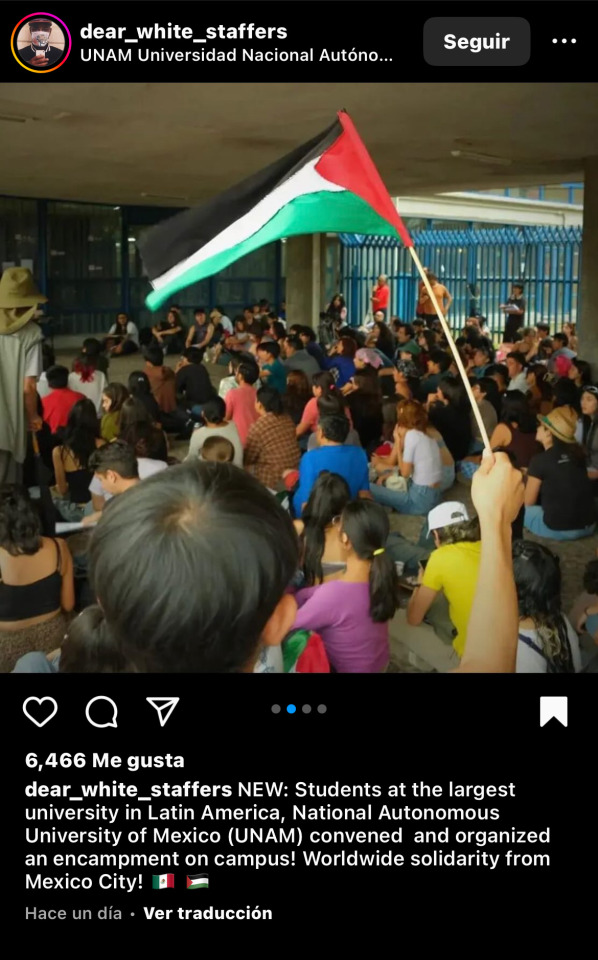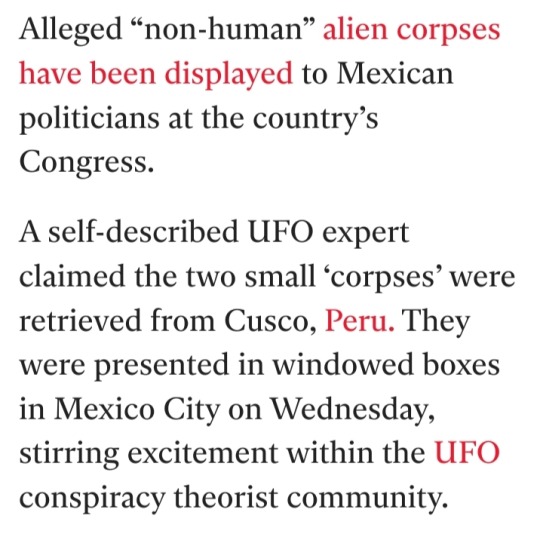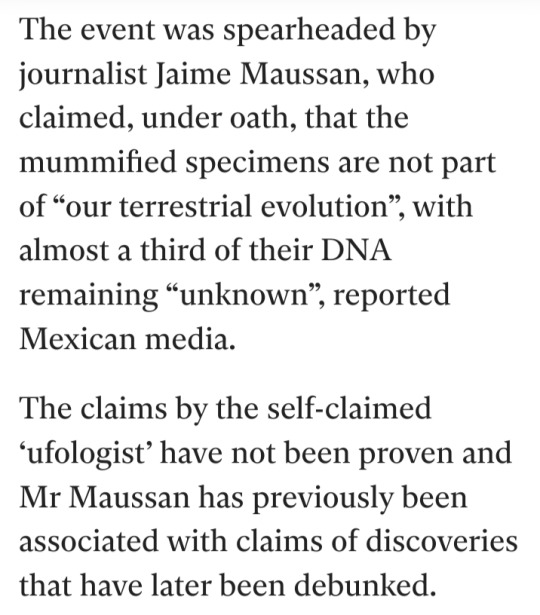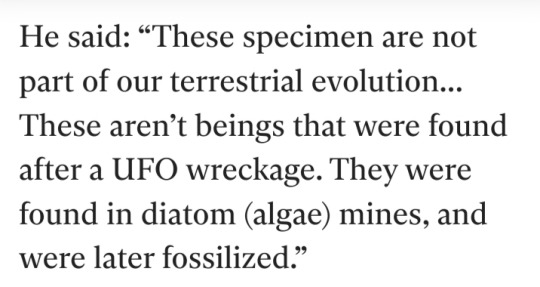#national autonomous university of mexico
Text

Earthquake Reveals Aztec Snakehead Beneath Mexico City
Researchers are conserving a rare snakehead from the Aztecs that still retains its painted colors from hundreds of years ago.
An earthquake last year revealed a big surprise beneath a law school in modern-day Mexico City: a giant, colorful snakehead from the Aztec Empire.
The snakehead dates back more than 500 years, to when the Aztecs controlled the area, which at the time was part of the flourishing capital of Tenochtitlan. The sculpture was discovered after a magnitude-7.6 earthquake struck Mexico City on Sept. 19, 2022; the seismic event caused damage and changes in the topography, revealing the snakehead beneath a building that was part of a law school at the National Autonomous University of Mexico, Mexico's National Institute of Anthropology and History (INAH) said in a Spanish-language statement.
The Aztecs built temples and pyramids and worshipped a number of deities, including Quetzalcoatl, who was often depicted as a snake. However, it's unclear if this sculpture depicts him, the archaeologists said.
The sculpted snake is 5.9 feet (1.8 meters) long, 2.8 feet (0.85 m) wide and 3.3 feet (1 m) high, and it weighs about 1.3 tons (1.2 metric tons), the INAH said. Several colors — including red, blue, black and white — are preserved on the sculpture.

Color was preserved on about 80% of the sculpture's surface. To keep it preserved, an INAH team lifted the snakehead out of the ground with a crane and constructed a humidity chamber around the sculpture. This chamber allows the sculpture to lose humidity gradually, with its color being preserved, María Barajas Rocha, a conservationist with the INAH who worked extensively on the sculpture, said in the statement.
While other snakehead sculptures have been found at Tenochtitlan, this one is particularly important for its preserved colors, said Erika Robles Cortés, an archaeologist with the INAH.

"Thanks to the context in which this piece was discovered, but above all, thanks to the stupendous intervention of the restorers-conservators led by Maria Barajas, it has been possible to stabilize the colors for its preservation in almost all the sculpture, which is extremely important, because the colors have helped us to conceive pre-Hispanic art from another perspective," Robles Cortés told Live Science in an email.
The sculpture's "sheer size is impressive, as well as its artistry," but the survival of the colors is remarkable, said Frances Berdan, a professor emeritus of anthropology at California State University, San Bernardino who was not involved with the excavation. "The survival of black, white, red, yellow, and blue paints is particularly interesting — one gains a good image of the visual impact of such sculptures as they were arrayed about the city center," Berdan said in an email.

In addition to its preserved colors, the snakehead's size is notable, said Bertrand Lobjois, an associate professor of humanities at the University of Monterrey in Mexico who is not involved in the excavation. The "first time I saw this serpent head, I was dazzled by its dimensions," he said in an email.
Lobjois also praised the conservation work that allowed the colors to survive, noting that "the conservation process allows us to appreciate the naturalistic approach of figuration" the Aztec artists used.
This work is ongoing and will continue at the site into next year.
By Owen Jarus.
#Earthquake Reveals Aztec Snakehead Beneath Mexico City#National Autonomous University of Mexico#Quetzalcoatl#sculpture#stone sculpture#ancient artifacts#archeology#archeolgst#history#history news#ancient history#ancient culture#ancient civilizations#aztec culture#aztec history#aztec mythology#aztec gods#aztec empire#aztec art
547 notes
·
View notes
Text

‼️🇵🇸🎓🇲🇽 The students of the National Autonomous University of Mexico have joined the student encampments in support of Palestine!
🔸 Source: Dear_white_staffers
#viva palestina#palestine#free palestine#unam#universidad nacional autonoma de mexico#national autonomous university of mexico#mexico#gaza#free gaza#israel#palestine news#jerusalem#tel aviv#students for justice in palestine#latin america
221 notes
·
View notes
Text

Lead study Mexican author Luis Rodríguez, a professor emeritus at the Institute of Radio Astronomy and Astrophysics at the National Autonomous University of Mexico
In 2023, the James Webb Space Telescope (JWST) helped identify hundreds of free-floating "rogue" planets that don't orbit a parent star. Now, astronomers have found that a pair of these planets may be producing enigmatic, hard-to-interpret radio signals.
The rogue planets spotted by JWST lie in the Orion Nebula, a long-time observational hotspot for astronomers. In total, they number over 500. This discovery bonanza was possible thanks to JWST's ability to pick up infrared radiation emitted by these relatively young planets.
Bizarrely, though, about 80 of these planets exist as pairs. Similar in mass to Jupiter, the planets orbit each other at distances ranging from 25 to 400 times the distance between Earth and the sun. These tangoing duos, called Jupiter-mass binary objects (JuMBOs), pose a huge mystery for astronomers, because the existence of these worlds challenges current theories of planet formation. Some scientists think these objects may not even be planets but rather previously unknown entities that are larger than planets but smaller than brown dwarfs, which are sometimes called "failed stars" because they blur the line between planets and stars.
The JWST data showed that JuMBOs generated infrared radiation, but the new study's authors wanted to see if these dancing objects produced radio waves. That's because different classes of cosmic objects produce distinct patterns of radio emissions. For instance, planets like Jupiter spew several types of radio signals, including gigahertz-frequency emissions thousands of times higher-pitched than an FM signal, partly because of their magnetic fields.
Spotting such signatures from the JuMBOs could help resolve their identity. The observations could also explain "why some objects have detectable radio emission and others do not," lead study author Luis Rodríguez, a professor emeritus at the Institute of Radio Astronomy and Astrophysics at the National Autonomous University of Mexico, told Live Science in an email.
To find radio wave "snapshots" of the Orion Nebula where the JuMBOs reside, the scientists combed through archives of observations maintained by the U.S. National Radio Astronomy Observatory (NRAO). They found just one pair that apparently emits radio waves: JuMBO 24. Itself an oddity among the oddball objects, it's the heaviest of the JuMBOs, and also the one with the tightest space between its component planets.
A decade's worth of data the research team collated showed that the radio waves remained steady but strong, with a power of roughly a quarter of a ton of TNT and frequencies of 6 to 10 gigahertz. The radio waves also weren't circularly polarized, meaning they lacked spiral, twisting electric fields, the team reported in their study, published Jan. 8 in The Astrophysical Journal Letters.
But these features aren't what astronomers expect of signals created by planets." Circular polarization is an unambiguous indicator of the presence of magnetic fields," Rodríguez said. Without this, the team can't say definitively that the signals come from JuMBO 24 (assuming the planets have magnetic fields). Besides, radio emissions from other exoplanets are more variable and less intense.
Even if JuMBO 24 isn't a pair of planets but rather another type of cosmic duo, the signals are unusual. Signals from brown dwarfs are very different from the newly identified radio beams. The beams' brightness and frequency even ruled out the possibility of pulsars, the rapidly spinning cores of dead stars that produce pulses of radio waves at regular intervals.
The researchers also estimated the likelihood that the signals originate from an object behind JuMBO 24 and found it to be exceedingly slim, at just 1 in 10,000. And, in case you were wondering, the signals probably don't originate from aliens. "The fact that both components emit at similar levels favors a natural mechanism," Rodríguez said.
With the research at an impasse, the team is applying to the NRAO's Very Large Array in New Mexico to collect data from free-floating planets. Until then, the radio signals will remain a mystery.
#🇲🇽#STEM#Luis Rodríguez#mexican scientists#astronomy#science#Institute of Radio Astronomy and Astrophysics#National Autonomous University of Mexico#James Webb Space Telescope#JWST#radio signals#planets#orion nebula#Jupiter-mass binary objects#JuMBOs#brown dwarfs#jupiter#JuMBO 24#The Astrophysical Journal Letters#pulsars#mexican#latino#hispanic
10 notes
·
View notes
Text

14 September 2023









#alien corpses#UFO#ufologist#Jaime Maussan#Autonomous National University of Mexico (UNAM)#DNA#US Congress#Mexico#Cusco#Peru#Ryan Graves#Americans for Safe Aerospace#ufology#UFO conspiracy theory
3 notes
·
View notes
Video
youtube
Mexico Top University IQ Test #iqtest #freeiqtest #quiz #quiztime #quizg...
#youtube#IQ Test available for National Autonomous University of Mexico Tecnologico de Monterrey Monterrey Institute of Technology and Higher Educati
0 notes
Text
Art Sense Ep. 115: Museums of Tomorrow Roundtable
In April of this year, the Museums of Tomorrow Roundtable brought nearly two dozen museum directors from around the world together in Silicon Valley to discuss the evolving role of technology in museums. As dialogs between museum directors and technology leaders in Silicon Valley evolved, it became apparent that planning for the use of artificial intelligence had become a critical need.
On today’s episode, I’m honored to be joined by four museum executives who are an active part of these conversations about the future of museums:
Thomas P Campbell
Director and CEO of the Fine Arts Museums of San Francisco
Seb Chan
Director & CEO at the Australian Centre for the Moving Image in Melbourne, Australia
Amanda de la Garza
Director General of Visual Arts at the National Autonomous University of Mexico in Mexico City and head of its University Museum of Contemporary Art
Suhanya Raffel
Executive Director, M+ Museum in Hong Kong
#2023#Seb Chan#Suhanya Raffel#Amanda de la Garza#Thomas P Campbell#Australian Centre for the Moving Image#Fine Arts Museums of San Francisco#Visual Arts at the National Autonomous University of Mexico#M+
0 notes
Text

"Palestinian resistance is not terrorism"
Stencil seen in the National Autonomous University of Mexico (UNAM) in Mexico City
4K notes
·
View notes
Text

To save axolotls, a campaign in Mexico asks people to virtually adopt them
Despite their never-ceasing grins, axolotls have been at risk of extinction for years.
Over two decades ago, there were about 6,000 of these tiny salamanders for every square kilometer in Lake Xochimilco in Mexico City. In the last count from 2014, there were only about 36 axolotls per square kilometer, according to Luis Zambrano, who was involved in the axolotl census.
"It's gotten worse. They're not completely extinct, but it's worse," said Zambrano, who is also an ecologist at the National Autonomous University of Mexico.
Although their population has dwindled dramatically over the years, the creatures are more popular than ever thanks to social media and the video game Minecraft. Becoming an online sensation has also led to real world impact in pet stores, where demand for axolotls has skyrocketed...
Read more: https://www.npr.org/2023/11/27/1215247480/save-axolotls-mexico-endangered-virtual-adoption
____________________________________________
Find out more and help axolotls:
Preguntas Frecuentes | Restauración Ecológica (restauracionecologica.org)
#axolotl#endangered#salamander#conservation#mexico#north america#animals#nature#amphibian#herpetology#science#environment
385 notes
·
View notes
Text

The Encampments Spread to Mexico
https://crimethinc.com/encampmentUNAM
On May 2, students from a number of schools and student organizations across Mexico City launched a Palestine solidarity encampment in the heart of the National Autonomous University of Mexico (UNAM), within view of the Okupa Che, a 24-year-running anarchist squat that once served as the UNAM’s largest auditorium. They established the encampment as an expression of solidarity with the wave of university encampments taking place in the United States against the Israeli state’s genocide in Gaza. By the end of the encampment’s first day, it already involved fifty tents, a free kitchen, and the visual redecoration of the space around it with messages of solidarity with Palestine.
We conducted this interview in person with a well-connected participant.
129 notes
·
View notes
Text
3/5/2024
Today's breaking news:
The National Autonomous University of Mexico joins the global student uprising for Gaza.
Palestinian families set up tents on top of the rubble of destroyed homes in the Beit Lahia project in northern Gaza.
At least 8 innocent civilians, including children, were killed in an Isr@eli airstrike last night which targeted a house for the Shaheen family in Rafah.
Isr@eli artillery strikes a location in the vicinity of the town of Khiam in southern Lebanon
The Turkish Ministry of Trade has announced the suspension of all trade exchanges with the Isr@eli occupation over the ongoing genocide in the Gaza Strip
Students at the University of Toronto, Canada, join the global student uprising for Gaza.
Hundreds of students at Seattle University join the international student action for Palestine. They are demanding their university divest from the Isr@eli occupation.
The Republic of Trinidad and Tobago has formally recognized the State of Palestine.
Isr@eli occupation forces block access of several worshippers into the Al-Aqsa Mosque compound in occupied Jerusalem ahead of the weekly Friday prayer.
The United States and Saudi Arabia are very close to reaching a deal that would provide Riyadh with security assurances from Washington while moving the Gulf kingdom away from US rivals.
The Ministry of Health in Gaza says the number of healthcare workers killed by the Isr@eli occupation since October 7, 2023, has surged to 496.
Gaza encampments have been established in Japan at Waseda University and the University of Tokyo
Isr@eli occupation boats open fire on Palestinians off the coast of Gaza City
Isr@eli occupation aircraft bomb residential areas in northern Gaza.
Isr@eli occupation launch airstrikes on the towns of Maroun al-Ras and Aytroun in southern Lebanon.
Displaced Palestinians raise Palestinian flags atop the ruins of their destroyed homes in Gaza City upon returning to them after weeks of Isr@eli occupation attacks and the recent withdrawal.
UN Special Rapporteur Francesca Albanese calls for global measures against Isr@el for deliberately targeting civilians in Gaza.
Palestinian civilians attempting to reach aid dropped on destroyed buildings in northern Gaza faced casualties as structures collapsed.
The World Health Organization (WHO) expressed grave concern over the potential for a bloodbath in Rafah, southern Gaza, due to a threatened Isr@eli ground invasion.
Isr@eli occupation forces detained the wife of Middle East Eye correspondent, Mohammed al-Hajjar, Inas Abu al-Maza, at a military checkpoint in the central Gaza Strip. Separating the family as they traveled south to Rafah
Students at Princeton University in New Jersey have initiated a hunger strike in solidarity with Gaza.
An Isr@eli soldier shares an image of a Palestinian abducted, partially stripped, blindfolded, and handcuffed in Gaza on his social media account
Isr@eli occupation airstrikes target tents of displaced Palestinians in Rafah
#free palestine#palestine#from the river to the sea palestine will be free#pro palestine#boycott starbucks#boycott disney#gaza#boycott mcdonalds#boycott israel#news from the world
44 notes
·
View notes
Text

A female inmate at Mexico’s Chalco Penitentiary and Social Reintegration Center has reported that she was sexually assaulted by a trans-identified male who had been placed in her cell.
The male inmate had a history of sexual violence, and threatened to harm the victim’s children if she spoke out about what happened to her.
The assault occurred in July of 2022 after the trans-identified male inmate was transferred into the victim’s quarters. Despite having a history of violent sexual crimes and misconduct, the perpetrator was allowed to move into the women’s area where there was minimal security, with some sections being separated only by fabric curtains.
While the victim had initially been threatened into silence as the trans-identified male had promised to harm her family using contacts he had on the outside, she eventually reported the assault to prison authorities.
CODHEM, the Human Rights Commission of the State of Mexico, launched an investigation and determined that “one of the [incarcerated women] was sexually assaulted by her roommate, who was a trans woman with previous complaints of misconduct and probable sexual harassment.”
CODHEM further revealed that “the aggression was not prevented by the prison authorities,” with the facility administrators having conducted an insufficient assessment of the inmate without follow-up and with no consideration for the possible risks the trans-identified male inmate posed to the women.
But disturbingly, despite affirming that the sexual assault had taken place and that the transgender inmate had been a risk to the women, CODHEM ordered prison staff to attend a “gender perspective” course.
As reported by El Gráfico, members of the Interdisciplinary University Seminar on Citizen Security at the National Autonomous University of Mexico were in charge of giving the course on human rights and “gender perspective” to eighty prison officials.
The same University was recently embroiled in scandal after trans activists staged a “coup” and took control over one of the largest women’s washrooms on the campus in protest of a lesbian mural being painted nearby. Trans activists vandalized the washroom, painting graffiti that threatened women critical of gender ideology with “rape and death.”
Despite Mexico’s political constitution outlining that prisons must be sex-segregated, the National Human Rights Commission of Mexico has declared that there is no “strict difference between men and women.”
Since news of the assault broke, Mexican media have almost uniformly referred to the assailant as a “woman,” or “trans woman,” using feminine pronouns to refer to the rapist.
Speaking to Reduxx on the disturbing case, Laura Lecuona, the head of WDI Mexico and author of Gender Identity: Lies and Dangers, slammed CODHEM for perpetuating gender self-identification policy in light of the obvious risks it posed.
“A man with a history of sexual violence is serving his sentence in a women’s prison, where he raped and threatened a cellmate, and the state human rights commission thinks that the solution is to give prison employees a little course on ‘gender,'” Lecuona says, questioning: “What will they teach them in this course? Likely that ‘trans women are women.’ The only solution is to recognize that self-declaration of sex involves several dangers for women.”
Lecuona also says gender self-identification policies must be “abandoned” completely in order to protect women.
“Feminists have been warning about this for years. There is still time [for authorities] to rectify and fulfill their obligation to guarantee women a life free of violence.”
The employment of “gender” counselors in cases where women have been involuntarily housed in close quarters with men who declare a transgender identity is an international phenomenon. In July, Reduxx revealed that a man who identifies as transgender presented a speech for a Women’s Empowerment event held at New Jersey’s only correctional facility for women, where he lectured female inmates on the importance of “inclusivity.”
La’Nae Grant reportedly told the women that he believed “cisgender women” may hesitate to accept trans-identifying men as female due to jealousy or “competition” between the groups for male sexual partners. The Edna Mahan Correctional Facility for Women has been plagued by violent male convicts being transferred into the prison, including a sadistic trans-identified male inmate who was handed a 50-year sentence in 2003 for the brutal rape and murder of a sex-trafficked woman from Ecuador.
.
.
.
.
Placing males' feelings and delusions before women and compromising their security in the process... Absolutely terrible. I took my time to read about Perry Cerf (the man mentioned at the end of the article) and I was this close to vomiting. The description of his crime and what he did to the woman (who was referred as a 'hooker' by other media outlet... Nice) is gut-wrenching so be careful.
And the immediate solution to a sexual assault committed by a trans-identified male in a women's prison is taking courses on gender perspective, suggested by the National Human Rights Commission out of all people... Noted.
96 notes
·
View notes
Text




Dozens of people, students and social organizations gathered on Tuesday afternoon in the vicinity of the embassy of the State of Israel in Mexico City to condemn the massacre on the encampments in Rafah, which occurred this Sunday, where at least 45 Gazan refugees were burned alive by the bombings of the Zionist army, the majority of the victims being children and women.
Among the protesters in Mexico were those who participated in the Gaza solidarity camp inside the University City of the National Autonomous University of Mexico (UNAM). In line with the movement developed among university students from many European, American and Latin American countries, among others, Mexican students protested in front of the embassy, in repudiation of the bloody attack on a refugee camp in Rafah, which was responded to with brutal repression by the government of Mexico City.
Although the demonstration took place peacefully, the government of Mexico City, headed by Martí Batres, ordered an extreme security operation to defend the facilities of the Zionist embassy, where police began firing tear gas, explosives and stones towards the protesters, leaving two people injured, in addition to photojournalists reporting attacks by the same police.
This repression occurs precisely on the same day that the Mexican state joins South Africa's lawsuit for genocide by the Israeli state before the International Criminal Court, although maintaining a constant refusal on the part of the López Obrador government to break relations with the Zionist State.
-- "Solidaridad con Palestina. Reprimen en México protesta frente a la embajada de Israel" from La izquierda diario with additional photos by Pedro Pardo, 29 May 2024 8:45
26 notes
·
View notes
Text

Mexican scientist, Gerardo Ceballos, winner of the 16th edition BBVA Foundation Frontiers of Knowledge Awards in Ecology and Conservation Biology
The BBVA Foundation Frontiers of Knowledge Award in Ecology and Conservation Biology has gone in this sixteenth edition to two Mexican scientists who have documented and quantified the scale of the Sixth Mass Extinction, that is, the massive loss of biodiversity brought about by human activity. Gerardo Ceballos (National Autonomous University of Mexico, UNAM) and Rodolfo Dirzo (Stanford University) are hailed by the committee as “trailblazing researchers in ecological science and conservation,” whose joint work in Latin America and Africa “has established that current species extinction rates in many groups of organisms are much higher than throughout the preceding two million years.” In effect, by documenting losses of animals and plants in some of the Earth’s most biodiverse habitats, both have contributed to showing that today’s biodiversity crisis is, as the citation states, “an especially rapid period of species loss occurring globally and across all groups of organisms, and the first to be tied directly to the impacts of a single species, namely, us.”
The two awardee ecologists have catalyzed the global study of “defaunation,” a term Dirzo coined to describe the alterations causing the disappearance of animals in the structure and function of ecosystems. His research, says the citation, has revealed how the elimination of a single species can trigger pernicious “cascading effects” by disrupting the web of interactions it maintains with other organisms. This, in turn, has adverse effects on human wellbeing through the reduction of the goods and services they perform. His work has helped provide the “necessary scientific basis” to further the adoption of evidence-led conservation measures.
“The experimental work done by professors Ceballos and Dirzo has led the way in quantifying the extent of species loss,” explains a Research Professor in the Department of Integrative Ecology at Doñana Biological Station (CSIC) and secretary of the award committee. “And what is truly shocking about their results is that this species extinction rate, or ‘defaunation process’, as it is known, is advancing today at a speed several orders of magnitude above the rate recorded over the last two million years. This shows that we are up against a truly intimidating challenge; one that these two researchers have documented and assessed across thousands of vertebrate, invertebrate and plant species.”
Another committee member, a Research Professor in the Department of Biogeography and Global Change at the National Museum of Natural Sciences (CSIC) in Madrid, uses an analogy to highlight the importance of the awardees' work: “Imagine we are flying in a plane sitting next to the window. And looking out, we see bits of the plane falling off. It may not nosedive straight away, but the first thought that crosses the passenger’s mind is: how long can this plane keep flying without its component parts? Something similar occurs with ecosystems. As they lose their “parts'' or species, they also lose vital functions, and it is these functions that provide essential services. The work of Dirzo and Ceballos is a valuable addition to the understanding of how such losses affect the resilience and sustainability of our ecosystems, shedding light on the urgent need for conservation actions to preserve the integrity of these systems that are critical to our survival.”
An accelerating extinction rate driven by our own species
Ceballos and Dirzo's endeavors have advanced in tandem through most of their professional careers, with results in many cases complementing one another’s. But the origin of their collaboration lies back in the early 1980s, when both were studying at the University of Wales (United Kingdom), Dirzo pursuing his doctorate courses and Ceballos completing his master’s degree. They first connected over their shared concern at the increasingly evident impact on nature of human activity. “We started having conversations not just on scientific matters, but about how worried we were about the anthropogenic impact on the natural world we were seeing all around us,” Dirzo recalls.
Further ahead, Ceballos turned his research attention to the study of wildlife and the magnitude of the advancing extinction, while Dirzo centered his efforts on ecological interactions between plants and animals, and the consequences of this extinction.
Ceballos’ work on assessing current rates of extinction led him to explore comparisons with the rates of the past. “Evolution operates as a process of species extinction and generation,” he relates. In normal periods, more species appear than disappear, such that diversity gradually expands. There have been five mass extinction events in the last 600 million years, the last of which brought the demise of the dinosaurs. All had in common that they were catastrophic – wiping out 70% or more of the world’s species – had their origins in natural disasters, like a meteorite collision, and were extremely rapid in geological terms, lasting hundreds of thousands or millions of years.”
After a detailed analysis of numerous species, a research team led by Ceballos concluded – in a paper published in Science Advances in 2015 – that vertebrate extinction rates are from 100 to 1,000 times greater than those prevailing over the last few million years. “What this means is that the vertebrate species that have died out in the past 100 years should have taken 10,000 years to become extinct. That is the magnitude of the extinction,” he explains. His work pointed one way only; to the fact that the sixth mass extinction was already upon us, a scenario that for Ceballos has three major implications: “The first is that we are losing all that biological history. The second is that we are losing living creatures that have accompanied us through time and have been key in driving forward human evolution. And the third is that all these species are assembled in ecosystems that provide us with the environmental services that support life on Earth, like the right combination of gases in the atmosphere, drinking water, fertilization… Without these environmental services civilization as we know it cannot be sustained.”
The grave impact of extinction on ecosystem services
Species extinction is the last stage in the process, but Ceballos insists that population extinction is no less worrying, since it is these populations that provide environmental services on a local or regional scale. He gives an example: “It doesn’t matter if there are jaguars in Brazil if they have died out in Mexico, because the environmental services they performed in Mexico will have disappeared with them.”
Ceballos and his colleagues explored this concept in a study of prairie dog populations, which in the 1990s were thought to be pests and were the target of eradication campaigns. Through this study, published in 1999 in the Journal of Arid Environments, they were able to prove that, rather than pests, they actually play a vital role in maintaining their ecosystem, the grasslands of the southwest of the United States and north of Mexico.
“We found that prairie dogs were essential to the upkeep of ecosystem services, because if they are lost it sets off a chain of extinctions across the many other species who depend on them.” With these rodents gone, the soil becomes less fertile, erosion increases and the scrubland advances, wiping out the plants that serve as forage for livestock. “The impact on environmental services is colossal,” he affirms.
For the Mexican ecologist, the biodiversity crisis we are experiencing is of a magnitude similar to the crisis of climate change and both problems are closely interrelated: “We have to couple the issue of species extinction with the issue of climate change, and understand that it is a threat to humanity’s future.”
From deforestation to “defaunation”: the “cascading effect” of species loss
Rodolfo Dirzo states, "I was soon asking myself: these fascinating things I study, the ecology and evolution of plants and animals and their interactions, may not be around to study in future if we don’t start to do something about what is happening to natural systems.” This concern, which he shares with Ceballos, has guided Dirzo’s steps throughout his career, from Mexico to the United States.
By analogy with deforestation, he came up with the term “defaunation” to refer to the imbalance entailed by the absence of animals. “Everyone has a mental picture when they hear the word deforestation. They understand that what they are seeing is a problem, the erosion of ecosystems due to loss of vegetation. And it occurred to me that the word “defaunation” could be a way to highlight that, just as Earth’s ecosystems face a serious problem of deforestation, another serious threat lies in the depletion and possible extinction of animal species.”
The scientist began studying the effects of this phenomenon and published his findings in a chapter of the book Plant-Animal Interactions: Evolutionary Ecology in Tropical and Temperate Regions in 1991.
“Species do not live in an ecological vacuum,” he points out, insisting that it is not just species disappearances we have to worry about, but the extinction of species populations and, above all, species interactions, which should accordingly be a core focus of conservation actions.
Elephant poaching and the risk of pandemics
These effects, Dirzo explains, give rise to a phenomenon that he refers to as “winners and losers.” When these large animals die out locally, they are evidently losers, while smaller animals like rodents take advantage of their absence and therefore become winners. But these smaller animals also carry pathogens like Leptospira, Leishmania and even the bacteria that causes bubonic plague. So if populations of these pathogen-carrying animals increase, there is a greater chance that they will transmit diseases to humans. “We could be put at risk of suffering a new pandemic,” he affirms, “given the proliferation of these diseases and the current mobility of human beings.”
The researcher has verified these effects through experiments carried out in Africa. He and his team installed electrified fences in some very well-conserved parts of the savannah to stop large animals from entering. They then left other areas unfenced, so they could compare two identical ecosystems, one with large wildlife and one without. “We found that when an area is closed off to these animals, the savannah vegetation changes dramatically.” Further, the rodent population triples, as does the risk of diseases that can be transmitted to humans. In this way, he says, we get “a cascade that runs from elephant poaching to the real risk of a new human pandemic.”
In fact, it is not even necessary for a whole local population to die out for it to pose an ecological problem. If there are not enough individuals to maintain viable populations, the species in question can no longer interact with other organisms and fulfill its ecosystem function. It becomes what is known, says Dirzo, as a “living dead species.”
Hunting is just one human activity that can drive species populations totally or partially extinct and trigger such grave effects as a pandemic. Dirzo lists five key factors that drive defaunation: land use change for pasture or urban development; the overexploitation of resources; pollution – by anything from noxious chemical products to marine plastic waste; the introduction of non-native or invasive species in ecosystems where they don’t belong; and climate change. “But none of these five factors,” he adds, “operates in isolation: they are all interlinked, and this makes the challenge of dealing with biological extinction all the more complex.”
Laureate bio notes
Gerardo Ceballos (Toluca, Mexico, 1958) graduated in biology from the Universidad Autónoma Metropolitana-Iztapalapa (Mexico) and went on to earn master’s degrees from the University of Wales (United Kingdom) and the University of Arizona (United States), where he received his PhD in 1988. The following year, he took up a position at the National Autonomous University of Mexico (UNAM), where he is currently a Senior Researcher at the Institute of Ecology. He is the author of 55 books and numerous scientific papers, and some 200 applied studies in conservation and management that have featured in technical reports supported by institutions like the World Bank, the U.S. Agency for International Development or the State of Mexico Government. He is one of the forces behind Mexico’s endangered species legislation and the designation of over 20 natural protected areas covering more than 1.5 million hectares.
Rodolfo Dirzo (Cuernavaca, Mexico, 1951) completed a BSc in Biology at the Universidad Autónoma del Estado de Morelos (Mexico) then went on to obtain an MSc and PhD from the University of Wales (United Kingdom). Between 1980 and 2004 he held various teaching and research positions at the National Autonomous University of Mexico (UNAM), serving as a professor, Director of the Los Tuxtlas Biological Station and Chair of the Department of Evolutionary Ecology. In 2004 he joined the faculty at Stanford University, where he is currently Bing Professor in Environmental Science, Professor of Earth System Science, Senior Fellow at the Woods Institute for the Environment and Associate Dean for Integrative Initiatives in Environmental Justice. Dirzo has also taught in Argentina, Brazil, Canada, Chile, Colombia, Costa Rica, Nicaragua and Puerto Rico.
Nominators
A total of 47 nominations were received in this edition. The awardee researchers were nominated by Gretchen Cara Daily, Bing Professor of Environmental Science at Stanford University (United States) and 2018 Frontiers of Knowledge Laureate in Ecology and Conservation Biology.
#🇲🇽#STEM#Gerardo Ceballos#Rodolfo Dirzo#extinction#animal#plants#Science Advances#ecosystems#BBVA Foundation Frontiers of Knowledge Awards in Ecology and Conservation Biology#prairie dog#Journal of Arid Environments#livestock#climate chaange#biodiversity#defaunation#National Autonomous University of Mexico#UNAM#deforestation#elephant#pandemic#africa#living dead species#rodent#elephant poaching#hunting#Universidad Autónoma Metropolitana-Iztapalapa#Institute of Ecology#world bank#U.S. Agency for International Development
1 note
·
View note
Photo

On this day, 17 November 1983, six people of Indigenous and mestize origin founded the Zapatista Army of National Liberation (EZLN) in the mountains of Chiapas, Mexico. 11 years later, around 3,000 armed EZLN members launched an uprising taking control of a considerable amount of land in the region, freeing prisoners and destroying police and army barracks. In a counter-attack by the Mexican army, the guerrillas lost control of many towns and cities and retreated into the Lacandon jungle. Subsequently the Zapatistas established a number of self-governing autonomous communities, with a population of over 300,000 people who are mostly from the Chol, Kanjobal, Mame, Tjolobal, Tzeltal, Tzozil, and Zoque Indigenous communities. Other than personal property, private ownership was abolished, with collective ownership of land and collectively owned and run workplaces. Radical, democratic schools, where pupils are not graded, were established, as was a universal healthcare service, drastically improving public health and reducing infant mortality. The communities also have a strong commitment to Indigenous, women's and LGBT+ rights. So if you know five people who think like you, set up a group! Learn more about the Zapatistas, and Emiliano Zapata after whom they are named, in these books: https://shop.workingclasshistory.com/collections/all/zapatistas https://www.facebook.com/workingclasshistory/photos/a.296224173896073/2137908199727652/?type=3
245 notes
·
View notes
Photo

UNAM Central Library
National Autonomous University of Mexico
73 notes
·
View notes
Text
Excerpt from this story from EcoWatch:
Mexico could see record temperatures in the next two weeks, as extreme heat driven partially by El Niño blankets the country.
A lack of sufficient rainfall has left 70 percent of Mexico suffering from drought conditions, with a third experiencing severe drought, the national water commission said, as Reuters reported.
“In the next 10 to 15 days, the country will experience the highest temperatures ever recorded,” National Autonomous University of Mexico (UNAM) researchers said in a statement, as reported by Reuters.
In the coming two weeks, temperatures in Mexico City could soar as high as 95 degrees Fahrenheit, said Jorge Zavala, UNAM’s director of the Institute of Atmospheric Sciences and Climate Change.
The capital city was one of several cities in the country that recorded its hottest day earlier this month, and most residents do not have air conditioning.
Since the beginning of the hot season on March 17, extreme temperatures have killed at least 48 people, with most dying from heat stroke and dehydration, Reuters said in another report.
Hundreds of others have suffered from sunburn and other heat-related conditions, according to health ministry data.
At this time during last year’s hot season in Mexico, three heat-related deaths had been reported.
According to meteorologists, a high-pressure heat dome over northern Central America and part of the Gulf of Mexico stopped the formation of clouds, leaving Mexico and parts of the Southern United States exposed to unrelenting sunshine and scorching temperatures, The Associated Press reported.
Warm, moist air was transported northward from the equator by tropical southerly winds, adding to the rare string of hot days.
11 notes
·
View notes